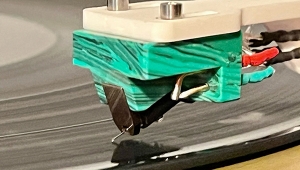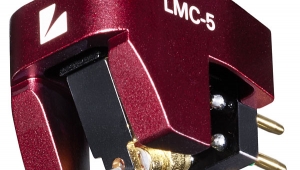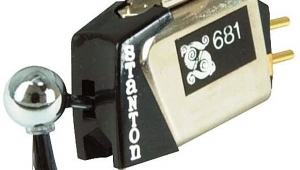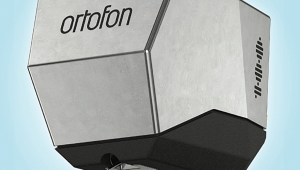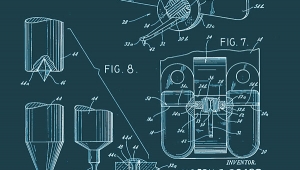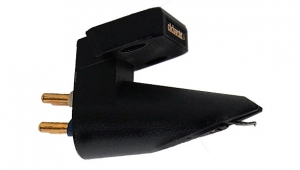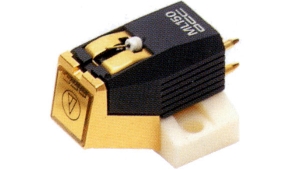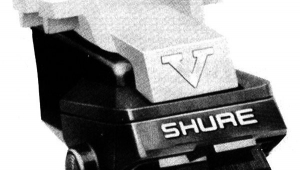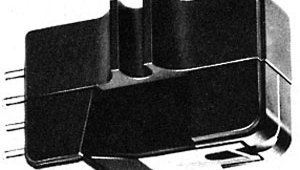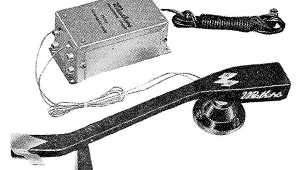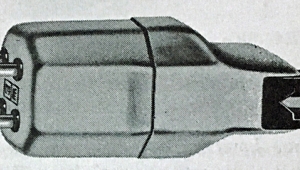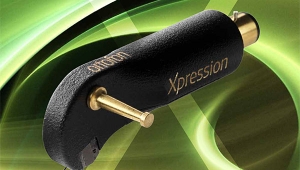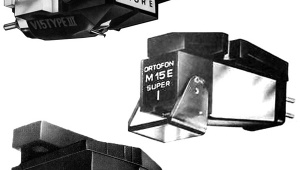| Columns Retired Columns & Blogs |
Decca Mark V phono cartridge Page 2
Yet there was no visible waveform distortion in the pickup's outputs over most of the audio range, and the overall sound gave every indication of very low distortion. (The Magneplanar speakers, remember, are single-ended devices, and seem to have extremely low distortion.) Only at low frequencies did we find the Mark V to have substantial distortion, and then only on vertical groove modulations. The distortion was entirely harmonic (not mistracking buzz), and was observed only on test discs, mainly below 80Hz. It seems Decca knew what they were doing here, for no such distortion was audible from musical recordings, and it took us a while to realize why. Most discs, it seems, are cut with the deep bass range in both channels mixed, to minimize severe vertical cutter excursions that would bother inexpensive pickups (including the mono pickups that some consumers are still using) as well as increasing the possibility of cutting through the master-disc lacquer into the aluminum base. Thus, the Decca pickup is just not exposed to the kind of vertical bass modulations that would produce substantial distortion.
Footnote 2: We will refrain from commenting at outraged length on Consumer Reports' absurd report on pickups in which the Decca was clobbered for having excessive tracking distortion at 1.7 grams, and for "pinging" when the cartridge is tapped with the fingernail. This is tantamount to criticizing a microphone for producing excess noise when nicking up a fly's footsteps and for going "thunk" when tapped with the fingertip.
Tracking, Tracing, etc
In connection with this, though, it is important to note that the tracking force at which the Decca is used can have a significant effect on its electrical distortion as well as on its tracking ability. At below 2 grams, electrical distortion is low but mistracking will start to occur. At above 3 grams, trackability will be excellent but electrical distortion and record wear will increase (footnote 2).
The Mark V has fairly high output—a virtually ideal figure which lies right mid-way between the limits imposed by most preamps by overload at one extreme and noise at the other. In addition, the pickup's unusually low electrical inductance (130mH) makes it far less likely to upset the feedback-equalization circuits in typical preamps. What this means is that, while Mark Vs may vary to some extent from sample to sample, a good one will sound the way it should regardless of what proamp it is used with, so long as the preamp has low distortion and passably accurate RIAA equalization. (The high-end response of high-inductance pickups can be thoroughly messed up by interaction with the equalization circuits in many solid-state preamplifiers.)
We have discussed the record-wear question in connection with spherical-styli pickups before, but it can bear repeating. The Decca has a spherical stylus, which gives a larger area of groove contact than an elliptical. Thus, while the tracking force of a spherical may be higher than that of an elliptical, the contact pressure may actually be lower, and it is pressure that does the groove damage, not force. The pressure exerted by a 0.5-mil spherical at 3 grams force is actually about the same as that exerted by the 2-mil contact radii of an elliptical at 1 gram.
The spherical does not give quite as clean tracing of high-level high-frequency modulations, but we have yet to observe it producing any more record wear with repeated playings than any elliptical.
The Mark V's tracking ability is, as mentioned, excellent, but it is not as good as that of either the Shure V15-III or the Ortofon M-15 Super. On most discs, there is no audible difference between the three in tracking cleanness. Only on a few discs with very high modulation velocities is a difference audible, in that the Decca will start to mistrack on an occasional note that the other two are still coping with. The new Shure trackability test disc (Era III) reveals the difference quite readily, but we must point out that the recorded levels on that disc are higher than any we have yet encountered on commercial discs of recorded music. The few discs on which we observed breakup on the Decca were obviously cut at lower levels than some of the bands on Shure's disc that the Decca sailed through, which would seem to suggest that the breakup may have been due more to imperfect groove shape (for a spherical, at least) than to excessive cutting levels.
When the Decca does start to mistrack, though, its superior detail becomes somewhat of a liability, for the stylus chatter is reproduced more offensively crisply than from either of the other two pickups. It can in fact set your teeth on edge. This may also be related to the lack of internal stylus damping in the Decca (which is probably what prevents it from going "sour" after a few months as a result of damping deterioration). The Decca's stylus will ring like a bell if not damped by the arm and by the groove vinyl (which is why CU noticed the "pings" when the pickup was tapped while not resting on a disc), and mistracking means that groove contact is being lost momentarily. The undamped styus could perhaps be considered a flaw in the Decca's design, were it not for the very real possibility that it is a major contributing factor in the pickup's unequalled (to date) realism and aliveness.
Because of the lack of internal damping, tonearm resonances have a more pronounced effect on the Decca than on other pickups, too. Slight torsional resonances that cause barely perceptible roughening of the sound of other pickups can put a marked edge on the sound of an intrinsically good sample of the Decca, as can pivot resonances and the undamped bass resonance between the cartridge compliance and the tonearm mass. Thus, while a fully damped arm like the Decca International will cause a perceptible improvement in the cleanness and sweetness of a typical pickup, it can make the difference between extraordinarily good sound or rather rough, glassy sound from a Mark V. So we will go on record as stating that, if you are not prepared to buy and install a Decca International arm, you cannot get the best performance of which the Mark V is capable. If you'd rather not, you can get almost as good results from a new Shure/SME 3009 Type II Improved arm. (Oddly, the sound in older SME arms is terrible—harsh, shattery and rough.)
A Rabco ST-4 sounds almost as good as the new SME arm with the Decca, but has earned a reputation as a system-buster because of its proclivity for scraping the stylus across the grooves as the arm lifts up at the end of a side. Paoli Hi-Fi 's Eugene Coggins estimates that more Mark Vs have been destroyed by use in the ST-4 than from any other single cause. The Mark V does not sound quite as good in a Rabco SL-8E as in an ST-4 (although it lasts a lot longer), but certain modifications (footnote 3) can make the SL-8E behave on a par with the Improved SME arm. We also learned, much to our surprise, that many users have gotten excellent results from Mark Vs in, of all things, that dreadful little arm that comes with the Acoustic Research turntables. Will wonders never cease...?
A few other caveats
Because of the proximity of the lateral polepiece magnets to the disc, there is a fairly potent magnetic field extending far enough below the cartridge to exert substantial attraction to a steel turntable platter. So use the Decca with a turntable having a brass or aluminum (or lead) platter. Secondly, although the Mark V is about as lightweight as any current-model cartridge, it does require higher tracking force than most, and some of the newer low-mass arms may not balance out to the proper value without the addition of some added weight to the headshell. The extra weight—2 to 3 grams—is beneficial rather than detrimental here, and should in fact be added to a low-mass arm even if you can balance out without it, for the Mark V's compliance at low frequencies is lower than usual, and may resonate within the audible range (ie, above 20Hz) if the tonearm mass is exceedingly low.
We reiterate what we said earlier, though: The Mark V is at its best in the Decca International arm (a headshell weight is normally supplied), and anything else will cost you cleanness and apparent smoothness.
Caveat three: Although not nearly as hum-sensitive as previous Decca pickups, the Mark V is not as well shielded as either the Shure or the Ortofon, and should be used only with 'tables having effectively shielded motors. Early Thorens TD-125s hummed with the Mark V; the TD-125 II and most other top 'tables are okay.
Finally, you may have heard some rumors to the effect that Deccas are fragile. In some respects, they are less so than the Shure and the Ortofon, both of which have exceedingly lightweight and vulnerable armatures. But whereas the Shure and Ortofon styli will merely retract harmlessly if dropped onto a disc, the Decca will probably be put out of action instantly (due to permanent stretching of the stylus-tieback cord). This is yet another good reason for using a viscous-damped tonearm. (The Audio & Design arm, which looks like a natural for the Decca, isn't. Its bias compensation is inadequate for the Mark V.)
Summing Up
This report has made the Decca look like a very iffy proposition, which in fact it is. After having weighed the many cons against the few but potent pros, though, we are inclined to give the Mark V (and its—generally—slightly better Export version) top place in the pickup pile. It may be a bit of a chore to find a really outstanding one, but in our opinion, the rewards of success make the effort worthwhile (footnote 4). You may not, however, have the stomach for such a search, in which case you'll have to resign yourself to accepting a somewhat lower level of program quality in exchange for the superior sample-to-sample consistency of a pickup like the Shure V15-III.
Footnote 2: We will refrain from commenting at outraged length on Consumer Reports' absurd report on pickups in which the Decca was clobbered for having excessive tracking distortion at 1.7 grams, and for "pinging" when the cartridge is tapped with the fingernail. This is tantamount to criticizing a microphone for producing excess noise when nicking up a fly's footsteps and for going "thunk" when tapped with the fingertip.
Footnote 3: As performed, at alarming cost, by Music & Sound Ltd in Willow Grove, PA, for example.
Footnote 4: See also Martin Colloms' and Michael Fremer's reviews of Decca (London) cartridges in 1995 and 2005.
- Log in or register to post comments
